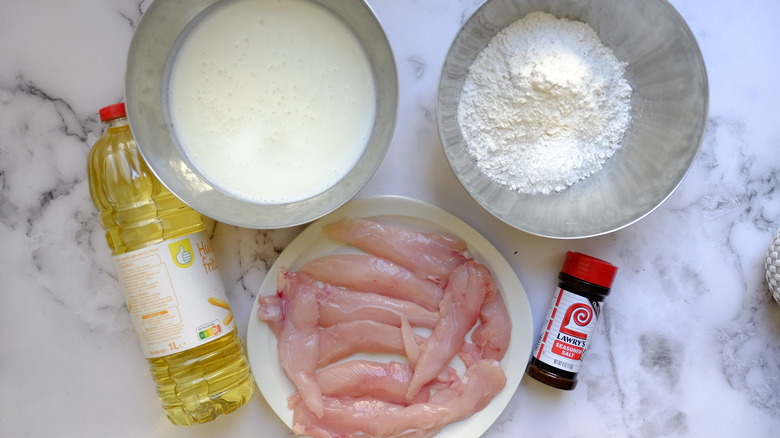Classic Chicken Tenders Recipe
If you enjoy eating chicken tenders from fast food restaurants, you're sure to love this DIY version. As recipe developer Eric Ngo tells us, "These chicken tenders are easy to make with ingredients from a common pantry and [are] a huge money saver." One of the best things about this recipe is the fact that you can tweak it to suit your own personal preferences. While Ngo makes these using flour mixed with store-bought seasoned salt, he says "You could make your own spice mixture by using garlic powder, oregano, white pepper, paprika, etc." You could also opt for a spice mix such as Old Bay or Cajun seasoning.
While Ngo keeps things simple in this recipe, he does have a tip if you want your chicken extra-crunchy. In this case, he says, "You can dip the marinated chicken tenders back and forth twice (not just once) from the buttermilk to the seasoned flour."
Gather the ingredients for classic chicken tenders
To make these chicken tenders, you can either use pre-cut store-bought tenders, or purchase boneless, skinless chicken breasts and slice them into tenders yourself. While Ngo purchased the former kind, he does say that when you slice your own, "Cutting them into tenders yourself gives you control on how big or small the chicken tenders will be." However, if you go this route, he notes that you should cut them all into roughly the same shape and size to ensure they'll have similar frying times.
In addition to the chicken, you'll also need buttermilk to marinate the chicken tenders. And for the crunchy coating, you'll be using flour mixed with seasoned salt (Ngo tells us "I used Lawry's"). Finally, you'll also need vegetable oil for frying.
Marinate the chicken
Combine the buttermilk with 2 tablespoons seasoned salt. Submerge the chicken in the seasoned buttermilk and allow the chicken to marinate for 2 hours. Be sure to refrigerate the chicken as it's marinating, as keeping it at room temperature for 2 hours might put you at risk of food-born illness.
Coat the chicken in seasoned flour
Mix the rest of the seasoned salt with the flour. Dip the tenders, one at a time, in the seasoned flour. Turn them over to make sure that there's an even coating of the flour on every part of the chicken — no bare spots allowed!
Fry the chicken tenders
Heat the oil in a large, heavy pan until it reaches 350 F. Fry the tenders for 5 minutes, but don't overcrowd the pan. Depending on how large your frying pan is, Ngo tells us that "You may need to fry this recipe in ... 2 separate batches." If you want to make sure the tenders are done, you can remove them from the oil and use a meat thermometer to make sure they've reached an internal temperature of 165 F.
Once your chicken tenders are cooked, Ngo suggests "These can be served as an appetizer with a condiment" and proposes ranch dressing, barbecue sauce, or sweet and sour sauce as possible dippers. If you want these tenders as a main course, you could pair them with a carb like mashed potatoes, fries, or rice, as well as a salad or other green vegetable.

- 12 ounces chicken breasts, sliced into tenders
- 1 cup buttermilk
- 1 cup all-purpose flour
- 4 tablespoons seasoned salt, divided
- 4 cups vegetable oil, for frying
- Mix the buttermilk with 2 tablespoons seasoned salt.
- Marinate the chicken tenders in the buttermilk for 2 hours in the refrigerator.
- Combine the flour with the remaining seasoned salt.
- Dip the chicken tenders in the seasoned flour, making sure they are entirely coated.
- Heat the oil to 350 F.
- Fry the chicken tenders for 5 minutes, or until their internal temperature reaches 165 F
- Allow the tenders to cool on a wire rack before serving.
| Calories per Serving | 725 |
| Total Fat | 50.7 g |
| Saturated Fat | 6.1 g |
| Trans Fat | 0.4 g |
| Cholesterol | 75.8 mg |
| Total Carbohydrates | 35.7 g |
| Dietary Fiber | 1.1 g |
| Total Sugars | 4.0 g |
| Sodium | 641.5 mg |
| Protein | 30.7 g |





